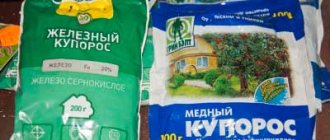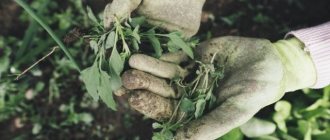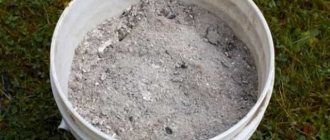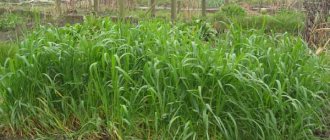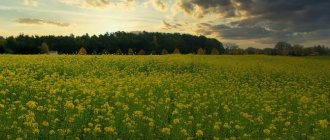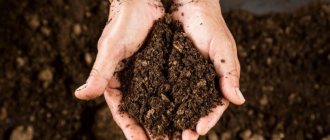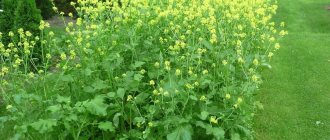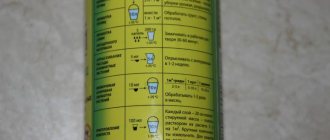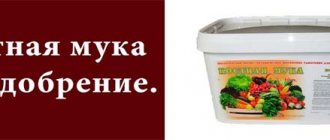This modern approach to farming has already won many fans. However, the method also has many critics who consider everything created by human thought for the purpose of modifying nature to be harmful and dangerous. Only one thing remains unchanged - EM drugs are not cheap and therefore are inaccessible to most summer residents, the majority of whom are pensioners.
But mastering the preparation of essential oils with your own hands is not so difficult, and you can find a lot of recipes on the Internet. I will introduce you to the most interesting of them in the article.
The role of microorganisms in the soil-forming process
Bacteria are the most ancient living organisms on our planet. They existed already when there were no plants or animals. And it was these microscopic inhabitants of the Earth that produced the first fertile layer, making the earth’s crust suitable for plant life.
Without microorganisms, no fertility is possible in principle, no matter how much fertilizer is put into the soil. Only they perform the following essential functions:
- decomposition and mineralization of plant and animal organic matter;
- fixation of nitrogen in the soil;
- oxidation of hydrogen sulfide and ammonia;
- reduction of nitrate and sulfate salts;
- precipitation of manganese and iron compounds;
- synthesis of amino acids, vitamins and enzymes in the soil.
Thus, bacteria and fungi are a kind of biochemical factory for the production of nutritional compounds, which are subsequently used by plants. It is microorganisms that can be considered real farmers.
There is a direct relationship between soil fertility and the quantitative and species composition of soil microflora. The more microorganisms, the more fertile the soil. In the rhizosphere (root layer) of “fat” chernozem there are tens of billions of them per 1 g of soil.
Composition of drugs and mechanism of action
The mixture contains strains of bacteria and fungi that are involved in soil formation. Microorganisms enter the drug in the form of spores. If the container is not opened and the microorganisms are kept in the dark and at a temperature of 15 to 25 degrees, then they can be stored for quite a long time.
In order for bacteria to “wake up”, they need lighting, nutrition, for example, sugar, and interaction with air. Diluting them with water and introducing them into a comfortable temperature range from 3 to 27 degrees helps the microorganisms begin to “work.” Bacteria in the soil begin to act if food is present.
Popular: How to use vermiculite for indoor plants and seedlings
Once all the conditions are provided, the bacteria begin to wake up in groups and eat the provided seed. Dying bacteria and the remains of their vital activity form loose nutritious soil, which is necessary for the active growth of plants. Such a fertile layer is formed not in several years, but in an accelerated period from 7 days to 3 months.
The essence and objectives of using EM technologies
The passion for intensive farming, the principles of which were applied by both agricultural producers and summer residents throughout the 20th century, led to a reduction in the area of fertile land. According to UN statistics, about 20 million hectares of arable land are completely degraded every year and become unsuitable for growing plants.
In this regard, in the West there has been active talk about a fundamental change in the approach to cultivating the land. EM technology has become one of the outposts of a new direction - the so-called “natural farming”.
The essence of EM technology is that in order to restore and maintain soil fertility, microorganisms participating in the soil-forming process are constantly introduced into it. The abbreviation “EM” actually stands for “effective microorganisms”. Live cultures of bacteria and fungi are grown in special laboratories and, in concentrated form, together with a nutrient medium, constitute EM preparations.
In Russia, the first scientist who began developing EM drugs and introducing them into agricultural practice was Pyotr Ayusheevich Shablin.
“EM technology is a technology for improving the environment. If the environment is sick, the person himself cannot be healthy.”
P.A. Shablin, Doctor of Medical Sciences, popularizer of EM technology in Russia
Distribution of EM drugs in Russia (click to expand)
Unfortunately, in Russia and the CIS countries, new farming methods have not yet become widespread among agricultural producers. By inertia, they continue to use intensive agricultural technology with the active use of pesticides and mineral fertilizers. However, among summer residents, natural farming methods and EM preparations are becoming increasingly popular.
Scope of application of EM drugs in crop production
Experienced gardeners who have long been familiar with EM preparations know that these microbiological compounds can be used in almost any process related to growing plants:
- when preparing seedling soil mixtures;
- for soaking seeds, bulbs and tubers;
- for watering and spraying seedlings;
ALL areas of application of EM drugs (click to expand)
- for spring preparation of beds and greenhouses for planting;
- for preparing warm beds;
- for watering and spraying plants in the ground and greenhouses throughout the growing season;
- for autumn tillage;
- for preparing compost and humus (find out → how to prepare humus).
EM preparations are also the only means that can help restore completely “killed” soil on old arable land, in gardens and vegetable gardens. Effective microorganisms very quickly make structureless soil lumpy and fertile, normalize acidity, reduce salinity, destroy pathogenic flora and destroy accumulated decay products of pesticides.
When switching to natural farming technology using EM preparations, in 4-5 years you can turn dead, infertile soil into living land capable of producing excellent harvests.
Home > k) Organic farming. > EM - drugs. Their composition. Application
Published October 11, 2013 Author: Valery Medvedev
The popularity of such drugs among gardeners today is so high that they are often used both for business and not, sometimes in violation of the technology for their use. Let's first figure out what they represent themselves. The prefix EM stands for Effective microorganisms that can live in natural conditions, that is, microorganisms that are already present in our gardens in varying quantities.
So, all EO preparations contain different cultures of beneficial microorganisms and, when used correctly, they can quickly increase the amount of beneficial microflora in the soil or on the surface, where it is lacking, thus increasing the natural fertility of the soil.
Most drugs include microorganisms of five families: Lactic acid bacteria produce lactic acid from sugar and other carbohydrates produced by photosynthetic bacteria and yeast. Lactic acid is a strong sterilizer. It inhibits harmful microorganisms and accelerates the decomposition of organic material. In addition, lactic acid bacteria promote the decomposition of lignins and cellulose and ferment these substances.
Photosynthetic bacteria are independent, self-sustaining microorganisms. These bacteria synthesize beneficial substances from plant root exudates, organic matter and toxic gases (for example, hydrogen sulfide), using sunlight and soil heat as energy sources. The beneficial substances they produce include amino acids, nucleic acids, other biologically active substances and sugars that promote the growth and development of plants. These substances are absorbed by plants directly and, in addition, act as food for developing bacteria. Thus, in response to an increase in the volume of photosynthetic bacteria in the soil, the content of other effective microorganisms increases. For example, the content of mycorrhizal fungi increases due to the availability of nitrogen compounds (amino acids) used as a substrate, which is secreted by photosynthetic bacteria. And mycorrhiza, in turn, improves the solubility of phosphates in soils, thus delivering previously unavailable phosphorus to plants.
Yeast synthesizes antibiotic and plant-beneficial materials from amino acids and sugars produced by photosynthetic bacteria, organic matter and plant roots. Biologically active substances such as hormones and enzymes produced by yeast stimulate the growing point and therefore root growth. They secrete (excrete) useful substrates for effective microorganisms such as lactic acid bacteria and actinomycetes.
Actinomycetes , which in their structure are intermediate between bacteria and fungi, create antibiotic substances from amino acids secreted by photosynthetic bacteria and organic matter. These antibiotics inhibit the growth of harmful fungi and bacteria. Actinomycetes are able to coexist with photosynthetic bacteria. Thus, both groups improve the condition of the soil.
Fermenting mushrooms. Fungi of the Aspergillus and Penicillium species rapidly decompose organic matter, producing ethyl alcohol, esters and antibiotics. They suppress odors and prevent soil contamination by harmful insects and their larvae.
Each group of beneficial microorganisms performs its function, while interacting with others, using substances carried out by each other, which leads to symbiosis and a multiple increase in efficiency compared to their individual use.
The most famous among such drugs is “Baikal EM1”
Proper use of these preparations makes it possible to increase natural fertility in soils rich in organic matter and prepare effective composts for depleted soils, while reducing the toxicity and pathogenic flora on these soils.
The preparations are widely used in organic farming, which excludes the use of mineral fertilizers.
They are sold in very concentrated form, so the effectiveness of their use will depend on the high-quality preparation of working solutions.
Preparation of the drug from con
To obtain the drug, the concentrate must be fermented as follows. For 3 liters of non-chlorinated boiled water at a temperature of 20-35 °C, add 3 tablespoons of molasses (sold separately) and 30 ml of concentrate, i.e. the entire bottle. . If molasses is unavailable, you can use honey or syrup from any jam. But since honey has a bactericidal effect, it should be added in small portions - 1 tbsp. spoon every day, only 3 to 6 tbsp. spoons depending on the quality of honey. Mix the solution well and keep in a glass container without access to air in a warm, dark place for a week. The readiness of the drug can be judged by the pleasant sour smell.
Syrup
Preparation of an aqueous working EM solution
Prepare a container for diluting the required amount of the EM drug. Warning! Do not use containers containing pesticides, petroleum products or chemically aggressive agents, because microorganisms may die.
Pour clean, non-chlorinated water at a temperature of +20-25 °C, without foreign odors, into the prepared container. Along with a certain amount of EM preparation for feeding microorganisms, the same amount of molasses is added to the water. The amount of EM preparation and nutrient medium is determined depending on the required concentration or based on a certain volume of water.
Example. To prepare 100 liters of an EM solution with a concentration of 1:1000, pour 100 ml of the EM preparation and 100 ml of molasses, or jam (without berries), or marmalade into 100 liters of water. To obtain 10 liters of EM solution 1:1000, add 1 tbsp to 10 liters of water. l EM preparation and the same amount of molasses.
You can store the EM solution for no more than 3 days! Important! Before diluting, the EM preparation should be shaken! If the EM preparation has been stored for a long time, it is better to first prepare the working solution in a concentration of 1:100, keep it together with the nutrient medium for 1-2 days, and then dilute it with water to the desired concentration. It is better not to use the prepared EM solution immediately, but to leave it for several hours to adapt the EM to new conditions. Do not expose the EM solution to direct sunlight! The greatest effectiveness is achieved when using the EM solution on the day of preparation.
Application of EM solution. Working (aqueous) EM solutions are prepared in various concentrations from 1:10 to 1:5000. For watering and spraying plants in open ground, for treating seeds, bulbs of flower and ornamental plants, and potato tubers, a working solution of 1:1000 is used. For watering seedlings and indoor plants, an EM solution of 1:2000 is used. For pre-sowing seed soaking, solutions of 1:1000 1:2000 are most often used. Spring and autumn tillage of plant-free soil is carried out with an EM solution of 1:100. To prepare EM compost, 1:100 EM solutions are used.
EM-compost
EM compost is a concentrate of organic matter fermented using an EM preparation. This is the most productive method of using available organic matter (tops, weeds, grass, manure, leaves, sawdust, bone meal, straw, food waste, etc.).
Good compost, like fertile soil, should have a carbon to nitrogen ratio of 11:1 (11 parts carbon to 1 part nitrogen). To feed microorganisms and plants, this ratio should be 25:1, and in plant residues this figure is 30-70:1, i.e. there is a large excess of carbon and a lack of nitrogen. When there is a large excess of carbon, the composting process slows down until the excess carbon escapes as carbon dioxide.
When there is a large excess of nitrogen, such as in fresh manure or bird droppings, the excess nitrogen will be released in the form of ammonia and nitrogen oxides. Nitrogen losses reach 30%. To obtain high-quality compost, when laying a compost heap, it is important to maintain the desired ratio of carbon and nitrogen.
It is important to know. To enrich the compost heap with mineral nutrients, you can add storage plants to it. Thus, comfrey accumulates potassium, buckwheat and melon leaves calcium, nettle nitrogen and iron, and mustard and rapeseed leaves phosphorus.
Unlike regular compost, which takes years to prepare, EM compost can be used within 3-4 weeks after laying.
Depending on the urgency of use and achievement of the required quality, compost is prepared aerobically (with air access) and anaerobic (without air access) methods. Aerobic compost is used for rapid fermentation of organic matter. The pile is laid evenly, without compaction (loose laying accelerates the decomposition of organic matter, but increases the loss of ammonia nitrogen). To increase air access to the compost heap, it is advisable to create a so-called “drainage” at its base. To do this, before laying the compost, drainage material (tree branches, lumber waste - bark, shavings) is laid on the soil surface. You can lay poles radially on the bottom and lay large branches on top. In this case, it is more convenient to aerate the pile by periodically shaking it by the outer ends of the poles. However, you can do without drainage material, the main thing is loose laying of compostable materials.
When laying EM compost, it is necessary to strive for a greater variety of components and a more uniform distribution of them in the heap. It is advisable to chop the tops and coarse stems of weeds. The EM preparation must be applied in layers as the heap is formed.
Compost humidity should be within 60%. The compost is ready for use within 1.5-2 months after laying, but can be used even after a month.
Important! During aerobic composting, the temperature of the pile often rises to 40-60 °C. This kills most of the microflora, including pathogenic ones, as well as helminth eggs, pest larvae and weed seeds.
To speed up the fermentation process, you can pour hot water over the pile (+80 °C). Only after “combustion”, when the temperature of the pile drops to 20-25 °C, is it necessary to reapply the EM solution. This EM compost can be added to the soil within 3 days.
The advantage of aerobic composting is that the fermentation period is shorter than with anaerobic composting.
Disadvantage: The temperature during the fermentation process is uncontrollable, which reduces the value of the compost.
Anaerobic compost is more effective than aerobic compost, since it retains the maximum amount of nutrients and more developed anaerobic essential oils, which are subsequently responsible for crop growth and its quality. In addition, a large amount of organic matter can be added at one time, and it does not need to be shoveled during the fermentation process.
Place compost in a hole up to 50 cm deep. Every 15-20 cm of crushed organic matter, add 3-5 cm of fertile soil (approximately 10% of the total mass), which is watered with an EM solution or EM extract at a concentration of 1:100-1: 250. The optimal humidity should be 50-60%, and the temperature should be +25 - +30 °C.
All components are compacted well to reduce air ingress. After installation is completed, the pile is covered with plastic film, and the edges are sprinkled with earth. You can cover the pile with a layer of grass. Depending on the size of the particles and air temperature, fermentation of organic matter lasts 3-5 months, although the compost is ready for use after 3-4 weeks.
Advantages of anaerobic compost: the nutritional value of organic matter is preserved.
Disadvantage: the silage-like mass causes inconvenience when applied to the soil.
Consumption of EM preparation: 1 liter per ton of any organic matter or 5 liters of EM solution (1:100) per 1 m2 of organic matter.
The greater the number of compost components, the higher its nutritional value.
A small amount of manure or poultry litter in the compost increases the speed of composting and its nutritional value.
EM compost obtained at temperatures above 45°C is almost 2 times weaker than compost fermented at temperatures of +20 - +30°C.
The longer the fermentation process of anaerobic compost, the higher its nutritional value and the less pathogenic microflora remains in it. Application of EM compost. 1. Fully fermented EM compost can be applied to the top layer of soil, free from plants, or into the rows at a rate of 0.5-1 kg per 1 m2 monthly, sprinkled with soil or mulched with organic matter (leaves, weeds, sawdust, etc.) .
2. In the spring, “autumn” EM compost is applied to the beds in the amount of 0.5-10 kg per 1 m2 1.5-2 weeks before sowing (planting) the plants, sprinkled with a layer of soil (at least 5 cm) and watered with EM-compost. solution in a concentration of 1:100 - 1:250. Consumption of EM solution is 2-3 l/m2. Before adding EM compost, the soil can be cultivated to a depth of no more than 5-7 cm, cutting off the root shoot weeds.
3. In autumn, EM compost is applied to the beds immediately after harvesting, in an amount of 0.5-10 kg per m2, and mulched with soil. The soil must be watered with clean water and then with an EM solution at a concentration of 1:100. Consumption of EM solution is 2-3 l/m2.
4. Summer watering of continuous sowing crops (carrots, beets, green crops, etc.) is carried out with a compost “matter”: 1 kg of EM compost per bucket of water. Mix everything well and filter, and the resulting liquid is diluted with water 1:10 (10 times). It is used to water the soil and plants.
5. Under bushes and trees - into depressions along the perimeter of the plant crown, made in 4-6 places - EM compost is added one shovel at a time and sprinkled with earth. It is enough to add EM compost once a month.
Important! EM compost added to the soil in the spring must be covered with a layer of soil of at least 5 cm, in order to avoid “burns” of the planted seeds and roots of the seedlings. Fresh compost (with fermentation less than one month), in order to avoid “burns,” should not be applied to the root or trunk zone of plants, since increased acidity and concentration of EOs can damage the roots.
You cannot apply EM compost at the same time as chemical fertilizers.
( 17 votes, average: 4.12 out of 5)
•
Review of EM drugs and their purpose
The oldest and most tested EM drug in Russia is the famous “Baikal EM-1”, developed by Pyotr Shablin himself. In addition to it, there are a lot of products similar in composition and effectiveness:
| Drug name | Description | average cost | Purpose |
| "Baikal EM-1" | A stable complex of lactic acid, nitrogen-fixing and photosynthetic bacteria and microscopic fungi - yeast and actinomycetes. Available as a liquid concentrate. | 400 rubles for 40 ml | Universal |
| "Vostok EM-1" | The predecessor of "Baikal", developed in Japan. Contains 84 strains of various microorganisms. Available in the form of a stock solution. | 230 rubles for 500 ml | Universal |
| "Renaissance" | A microbiological preparation in the form of a mother solution, similar in composition to “Baikal EM-1”. The formula was developed by the Russian concern Agrocom. | 125 rubles for 500 ml | Universal |
| "Shine" | A line of 3 microbiological preparations for different purposes. Available in powder form, it can be used both in dry form and in solutions. | 160 rubles per 100 g | “Siyanie-1” – for preparing soil, seedling soil mixtures, watering and spraying plants. "Siyanie-2" - for watering and spraying plants. “Shine-3” – for preparing compost and herbal fertilizers. |
| "GumatEM" | Contains humic acids and microbiological complex. Available in the form of a Russian stock solution. | 250 rubles for 250 ml | For tillage, watering and spraying plants. |
The rather high prices for EM drugs should not be scary. They are used in very large dilutions, and usually one bottle is enough to treat a standard six hundred square meters throughout the season.
Any of the EM preparations can benefit the grower. There are no “bad” or “good” ones among them. But the greater the number of strains contained in the product, the greater the benefits. In this regard, Vostok EM-1 is ahead of other drugs.
EM for pests and diseases
The drug Baikal EM-5 is used as a preventative against plant diseases and pests. Its composition (in order of components introduced):
- Pure soft dechlorinated water (preferably distilled) – 600 ml;
- Molasses or syrup (see above) – 100 ml;
- Table alcohol vinegar 9% - 100 ml;
- Medical grain alcohol 96% – 40 ml or 70% “for injections” – 55 ml;
- Basic solution of Baikal EM concentrate – 100 ml.
Before administration, add water up to 100 ml to a given volume of alcohol. Instead of alcohol, you can add 100 ml of Russian or Finnish 40-proof white vodka (without additives or flavorings) or English gin of the same strength. Polish 50-proof vodka is not suitable; it is not sufficiently purified from fusel oils for this purpose. Schnapps, Dutch gin and vodka bols are also not suitable - they are made not from grain, but from potatoes. Rice-based spirits (sake, Vietnamese vodka, etc.) are also unsuitable. Like whiskey, cognac, armagnac, Italian grape vodka grappa and other alcoholic drinks of fruit origin, they contain tannins.
The resulting EM-5 concentrate is poured into a liter or two 0.5 liter glass bottles, topped up with distilled water up to the top and plugged with gas outlet stoppers from a medical needle, see above. Fermentation containers are placed in a dark place with a temperature of +28-35 degrees. At the end of gas evolution (this is for 3-4 days), the gas outlets are removed. The finished concentrate is stored in a cool, dark place for up to 6 months.
For use, EM-5 concentrate is diluted immediately before use with water or an infusion of plants that have pesticide properties: leaves (feathers) of garlic, plantain walnuts, aloe vera or vera, tops of red hot pepper, carrots, yarrow herb; You can use mixtures of components in equal parts in any combination. The herbs are passed through a meat grinder, poured with warm water 2:1 by volume and infused at room temperature for 2-3 days in a sealed container in a dark place. To avoid fermentation, the finished infusion is stored in the refrigerator in the vegetable compartment (avoiding freezing).
Plants are regularly sprayed with Baikal EM-5 1-2 times a week from the beginning of bud break. Preventive dilution of the concentrate 1:500. The application rate is controlled visually: until a continuous film of moisture appears on the leaves. When the first signs of disease or pests appear, the concentration is increased to 1:300 and spraying is carried out daily. It doesn’t help - the concentration is increased to 1:100 and 2-3 treatments are carried out. The effect is not visible - well, it's time to use pesticides.
Note: herbal infusion can be added to the water of the spray solution in any proportion.
Application of EM preparations for soil treatment
EM preparations include microorganisms that naturally live in the soil. Accordingly, they live longer, reproduce faster and work more efficiently when placed in their natural habitat - in the ground.
For soil treatment, EM preparations are used as follows:
- In the spring, organic matter is laid out on the surface of the bed (compost, rotted manure, cut early green manure, etc.) and shallowly embedded into the soil with a flat cutter. Find out → how to use compost as a fertilizer, → different types of manure and their use in the garden). The EM drug is diluted according to the instructions, and the soil is watered with the solution. The bed is mulched to maintain moisture and positive temperature.
- In the summer, the beds and tree trunks are watered with the prepared EM solution at least once a month.
- In the fall, a warm bed is prepared for the next season. The organic matter contained in it is abundantly watered with an EM solution, sprinkled with earth and mulched with peat, straw or dry leaves. In the spring, before planting, the bed is watered a second time with an EM preparation. Find out → how to mulch beds with sawdust, straw, grass, leaves...
- At the end of winter, soil mixtures are prepared for seedlings. The mixture is generously sprayed with EM solution and left in a warm place for 2 weeks. After this, you can sow seeds into it.
Microorganisms require a certain temperature and humidity. In open ground, treatment with EM preparations begins after the onset of stable positive temperatures and warming up of the soil.
Preparing em-compositions yourself
Recipe 1
To prepare such a product you will need 25 liters of fertile soil. It is best to collect soil from the forest, take manure or humus from three years ago. The soil may have a layer of mycelium. The soil should not contain red, orange or other bright inclusions. You need to take the same amount of wheat bran, charcoal and twice as much sawdust. For the composition you need to take 0.2 kilograms of fresh yeast, five liters of jam (honey, molasses), two liters of unboiled milk. The amount of water is selected in this way: when clenched into a fist, the palm should remain wet, but the liquid should not ooze. The approximate amount of water is from three to six liters.
First, mix the dry ingredients of the mixture in a separate container. Liquid substances must be thoroughly mixed until smooth in another container. After this they are mixed. All this is poured into a separate container and covered with a lid with holes so that gases escape during fermentation. You can remove the gas using a hose. The free end of the hose is placed in a container filled with water. You can see how active the fermentation is by looking at the air bubbles. After about a week, gases stop coming out of the mixture. This means that the product is ready for use. The correct aroma coming from the mixture should be that of beer or bread. If something goes wrong during the fermentation process, the aroma of the mixture will be unpleasant and pungent.
You can use this fertilizer immediately or spread it in a thin layer in the sun until completely dry. For longer storage, it is better to dry the mixture. This way it can last up to 12 months.
The resulting preparation can be used to accelerate the maturation of compost. It is mixed with soil in holes when planting plants. The resulting product is also dissolved in water with jam and watered over the plantings. This mixture should “ripen” within 24 hours. It can be stored for 10 to 14 days. Water the leaves of plants with it, or you can pour it under the root.
Recipe 2
This recipe for making a product with microorganisms will be cheaper. To prepare it, it is enough to stock up on picked weeds or ordinary mown grass. It is important that the weeds are seedless. Fermentation will be enhanced by a liter of yogurt, sour milk, kefir or other dairy product and half a jar of regular jam. The jam should not be sour or fermented. A couple of handfuls of hay dust are added to the mixture to destroy pathogenic bacteria. You should dig up 250 grams of soil from the garden and pour water into a separate container. The preparation can be enriched with wood or herbal ash.
Popular: Which preparations with biofungicides are best to use for plants
Initially, you should chop the grass and fill the barrel with it, without adding the plant material to the edge of the container, to a height of five centimeters. The grass is filled with water from above so that the plant material is completely hidden. The remaining ingredients are mixed and poured into the barrel. The container is closed with a lid for a week. Once a day, the barrel should be opened and its contents mixed. The mixture is dissolved with water in a ratio of one to ten.
Recipe 3
The basis of such organic matter will be a mash of sugar and yeast. To prepare the preparation, you need to take a shovel of wood ash and five liters of manure, a shovel of humus, compost (garden soil), and a bucket of rotten straw. You need to pour a liter of fermented milk product into it, add a little sand. For fermentation, mash is prepared from three liters of water and ten teaspoons of granulated sugar.
First, the base of the product is prepared - mash. It is necessary to mix water and sugar. After this, the mash must stand for three days to ferment.
All ingredients are placed in a barrel, covered with a lid and left to ferment for ten days. The finished mixture smells like mushrooms and yeast. The smell should not be pungent. The concentrated product is diluted with ten parts of water and used to feed plantings.
Recipe 4
This is the most ancient method of preparing a solution with bacteria. It came from Asian countries. To prepare it, you need to take three liters of boiled rice, a kilogram of sugar, three kilograms of food waste or mowed grass.
The solution container (five-liter jar) must be sterilized with boiling water. 2/3 of it is filled with boiled cereal. After this, the jar is covered with a sheet of paper and the neck is tied with an elastic band. The jar is placed in a dark place, away from light. After a week, mold should develop in the jar.
Rice is poured into a large barrel, granulated sugar and organic matter are poured into it. All ingredients are thoroughly mixed. In this form, the product should “ripen” for 30 days. The resulting liquid at the bottom of the barrel must be decanted. After this, another kilogram of granulated sugar is added to the container and the product is removed to infuse for another couple of weeks.
The resulting liquid is diluted with water in a proportion of one part of the product to twenty parts of water and used to feed plants. You can use leftover fish instead of grass clippings or food scraps. But the composition turns out to be too concentrated. It is bred in a ratio of one to a thousand.
Currently reading:
- How to grow Chinese cabbage in open ground
- Using hydrogel in open ground for plants
- Planting to decorate the site with three types of coniferous trees
- Restoration and stimulation of orchid flowering with succinic acid
Share the news on social networks
About the author: Lyudmila Vasilievna Nosikova
Agronomist of the state agricultural enterprise "Garovskoe" of the Khabarovsk region of the Khabarovsk Territory.
Application of EM preparations for plant treatment
Plants can be given EM preparations either with irrigation water or by spraying. Such processing performs the following functions:
- protect roots from pathogenic soil flora;
- promote better absorption of nutrients from the soil solution;
- feed plants with biologically active elements - vitamins, amino acids;
- protect above-ground parts of plants from fungal and bacterial infections.
There are no restrictions regarding the timing or frequency of treatments of plants with EM solutions. These drugs are absolutely safe, and technically there can be no overdose.
EM preparations are suitable for spraying and watering any plants - vegetables, fruits, ornamentals, indoors. They can be used throughout the season, in warm weather. Spraying is carried out with protection from direct sunlight, which can “burn” microorganisms.
Recipe No. 2. The cheapest
It is better to take soil for fermentation in the area where green manure grew last year
If you do not have the opportunity to get any of the ingredients from the previous version of preparing the EM drug, I advise you to pay attention to the following recipe.
Ingredients:
- freshly cut grass, weeded weeds without seeds and other succulent organic matter;
- a liter of sour milk, old kefir or water formed after washing sour cream cups;
- a couple of handfuls of hay dust (bacillus hay perfectly destroys harmful bacteria that may inadvertently settle in your preparation);
- half a jar of old unnecessary jam (but not fermented!);
- half a liter of fertile soil from the site;
- water;
- You can also add a little humic fertilizer, as well as wood or grass ash.
Cooking method:
- Lightly chop the grass, fill the barrel to the top (not reaching the edge 5-10 centimeters).
- Fill the greens with water so that it completely covers them.
- Add the remaining ingredients to the mixture and mix well.
- Allow the biofertilizer to brew, covered, for 7-10 days. The container must be opened periodically (once a day) and its contents stirred with a long stick.
How to use:
Just like in the previous recipe, only this time you can take not 20, but 10 parts of pure water for one part of the EO preparation.
Application of EM preparations in the preparation of fertilizers
EM preparations are indispensable for preparing compost, humus or liquid herbal fertilizers:
| Fertilizer | Use of EM drugs |
| Manure humus ⊕ how to use | After the raw material stops “burning” and cools down a little, the manure is poured with EM solution and covered. Microorganisms speed up decay twice as much. |
| Compost ⊕ how to make (recipe) | When laying layers of organic matter, each layer is spilled or sprinkled with an EM preparation. Microorganisms prevent souring of biomass, the development of mold and accelerate the maturation of compost by 2-3 times, depending on the type of organic matter. |
| Herbal fertilizers ⊕ application | After filling the herbal mass with water, the EM preparation is added to the container. Microorganisms facilitate fermentation, enrich the solution with useful elements and eliminate unpleasant odors. |
Tip #1. Various microbiological products for septic tanks and cesspools are also EM preparations. Of course, you shouldn’t spray plants with them. But their microbiological composition is selected in such a way that these products quickly and effectively decompose any organic matter. Therefore, if there are no special preparations at hand, you can use a septic tank product as an accelerator for compost maturation.
Recipe 3. How to prepare your own EM preparation for legumes
If you grow a lot of legumes in your summer cottage, then to increase productivity, try preparing a special growth enhancer based on effective microorganisms.
To do this, mix one kilogram of soil with a tablespoon of lime (or chalk) and a glass of sand. Moisten the soil well, transfer it to a bucket and level it. Boil a handful of peas or beans in two glasses of water, then cool. The result is a nutrient solution.
Now you need to pull out 5-6 flowering pea plants by the roots. And pick off all the white and pink nodules from the roots. Then wash them off the soil and mash them well in a cup with a wooden spoon or masher. Mix everything that has been crushed with a third of a glass of nutrient solution. And pour it into a bucket with prepared soil. Cover the container with soil with film, in which you first make several holes, and place it in warm darkness.
In a week, the soil from the bucket will turn into an effective EM preparation for planting peas. It should be dried in the shade and stored until spring. During planting, soaked pea seeds are rolled in the preparation and immediately sown in the garden bed. Using the same principle, you can prepare a “growth stimulator” for beans and other legumes.
Terms of use of EM drugs
For microorganisms to work truly effectively, not only temperature conditions and normal soil moisture are important. The basic principles of natural farming must be followed. One of the main ones is the refusal of deep tillage with soil rotation.
“Why can’t you dig the soil? Soil is a habitat for billions of microorganisms. When we invade there with a shovel, we disturb this environment, preventing them from fulfilling their function. It’s irrational and pointless.”
E. Kokhanovskaya, head of the organic farming club
It is also important to constantly replenish organic matter in the soil. Organic matter is “food” for microorganisms.
Another important principle is constant mulching of the soil surface. Mulch maintains constant soil temperature and moisture, protects it from weathering and washing out.
Organic mulch is especially useful for microorganisms, as it provides them with additional nutrition and plants with carbon dioxide necessary for photosynthesis.
Technologies for using a solution of effective microorganisms
In Japan, even an EM philosophy arose. Preparations of effective microorganisms are considered a kind of “living water” that has a life-giving effect on everything around. They are used to maintain the health of pets, clean rooms and water bodies, and as dietary supplements. They suppress pathogenic soil microflora, protect against diseases, pests and harmful chemical compounds, increase productivity, accelerate the ripening of fruits and improve their taste, and contribute to their better preservation. The use of effective microorganisms eliminates deep plowing and chemicalization of agriculture, allows you to grow healthy crops, and protect the soil from excessive use of fertilizers and garden pest control products.
In our country, the pioneer in the development of technology for effective microorganisms was Peter Shablin. EM preparations contain strains of beneficial photosynthetic and lactic acid bacteria, yeast and other microorganisms, over 80 varieties in total. The solution of effective microorganisms can be used in crop production, livestock farming, fruit growing, in the preparation of animal feed, land reclamation, wastewater treatment and waste processing.
EM technologies are extremely effective in increasing agricultural productivity. Soaking the seeds doubles the yield, a single spraying of the seedlings increases the yield by 30%, and if this is done weekly - by 150%!
Reviews on the effectiveness of EM technologies
Summer residents who switched to natural farming and began to actively use EM preparations will never return to traditional agricultural technology:
“After I inherited a plot where salt “exudation” remained on the soil surface after watering, and the plants died en masse, out of hopelessness I rushed into organic farming. For two years in a row I didn’t sow anything except green manure, didn’t mow them, let them grow on their own and only watered them with “Baikal EM-1” in spring and autumn. In the third year, I created permanent beds. I didn’t dig anything, I only worked with a hoe and a flat cutter. Mulched and watered with EM solutions. In general, she poured them everywhere - both into the soil and onto the plants. Now, in my tenth year, I have excellent soil and harvests, and I will never give up “emochkas”” (Valeria, Moscow region).
Types of drugs
In stores you can buy brands with such composition. Farmers consider Tamir, Gumat EM, and Baikal EM the most popular of them. No less famous are Emix, Siyanie, and Niva EM-1.
Preparations with simple formulas can be made at home. The most famous product for composting and fertilizing plantings is Baikal EM. This product has no toxic effect, it is completely safe for plants, animals and people.
Popular: Proper spring planting of green manure in a greenhouse and in the ground
All drugs can be divided into several categories based on their composition:
- Baikal group. Their components are 20 strains of bacteria and fungi. They are suitable for making compost and are used as fertilizers to make animal feed. They are based on lactic acid bacteria and yeast;
- Group East. These are mixtures containing from 60 to 80 cultures. They are used on depleted soils, for example, loams, garden soils;
- Gumat EM Group. Such products are considered less effective than Vostok and Baikal, but humates are among their ingredients. They are designed for structuring dense and heavy soils, for example, virgin soil, meadow soils;
- Homemade preparations. The composition is selected by the gardener himself. Such mixtures are created independently, and not in laboratory conditions. They are recommended for use when making compost or if you decide to save on the use of fertilizers containing nitrogen.
Current questions about EM drugs
Question No. 1. Is it possible to make an EM drug with your own hands?
Can. For example, many people try to use “rice milk”. Pour a quarter cup of raw rice with water, stir, pour the cloudy water into a jar and add a spoonful of granulated sugar. Cover and leave in a warm place for a week. Then dilute with milk in a ratio of 1:10 and keep warm for another week. The resulting starter is diluted with water 1:20 and used for soil treatment.
Question No. 2. How effective are homemade EM preparations compared to professional ones? (click to expand)
Less effective. At home, it is impossible to achieve the kind of diversity of microorganisms that is offered by the laboratories of manufacturers of EM drugs.
Rate the quality of the article. We want to be better for you:
